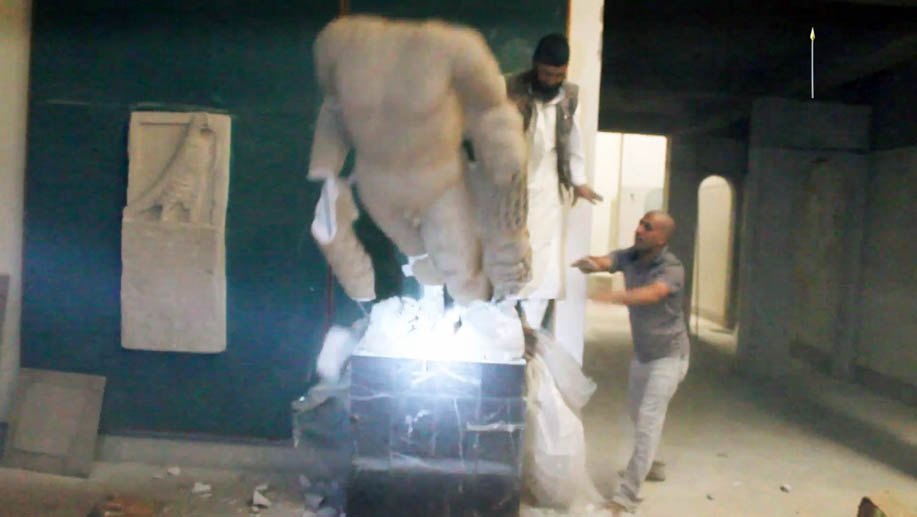Among the innumerable tragedies brought about by war is the destruction of cultural artifacts that hold the keys to our collective human history. In the wake of the most recent US war in Iraq, the self-proclaimed Islamic State has further devastated the country in an attempt to control the region. After already conveying to the world acts too horrific to watch, the group of extremists took to destroying ancient artifacts at the Mosul Museum in Iraq as a form of cultural subjugation.
While there are actions taken by ISIS that can’t be reversed, one group is hoping to at least preserve the human history previously displayed at the Mosul Museum. Led by the Initial Training Network for Digital Cultural Heritage, Project Mosul is reaching out to volunteers that can help restore the artifacts from the Mosul Museum. With volunteers submitting photos, processing data, and providing other duties, Project Mosul is seeking to recreate the museum digitally and, hopefully one day, physically as well.
Project Mosul writes on their site:
The video circulated around the 26th of February, 2015 shows the horrific destruction of the Mosul Museum by ISIS Fighters. This is not the first time this museum has suffered during times of conflict, but the destruction is nearly absolute, and this time we can respond through the application of digital technologies to cultural heritage.
We assume that much of the museum’s contents were looted, and anything small enough to be easily removed will be appearing soon on the antiquities market. Anything too large to remove for sale, appears to have met a violent end at the hand of ISIS extremists. In both cases, it is possible to virtually recreate the lost items through the application of photogrammetry and crowdsourcing. Given enough photographs, digital or scans of analogues, it is possible to reconstruct the artefacts and create digital surrogates of those artefacts. This provides two immediate benefits: helping to identify looted items and recreating destroyed items.
As seen with such endeavors as the MicroPasts project, photos of objects from the museum from a number of angles can be used to reconstruct 3D models of the artifacts with photogrammetry. In addition to submitting photos, volunteers will also be needed to mask the images of the artifacts in Photoshop, an essential step in the photogrammetry process. The group is also looking, via their GitHub page, for programmers to help develop a web platform to display and possibly mask the artifacts. And, if you know how to use photogrammetry software yourself, you can begin processing the data they’ve collected so far.
So far, Project Mosul has already been able to digitally reconstruct part of one artifact, The Lion of Mosul. With the first batch of images received by the organization, donated mostly by volunteers Suzanne E. Bott, Col. Mary Prophit, and Diane Siebrandt, a partial reconstruction was achieved:
Project Mosul has only just begun and the group will need even more help as they take off, not only with direct contributions to the project, but also by spreading word about the group’s efforts. So, if you know anyone who has visited the museum, you can direct them to the project website to contact the Project Mosul team. Project Mosul has additionally launched a Slack live chat and Google Group devoted to the project, to enlist further volunteers.
The efforts contributed to Project Mosul, as with other artifact preservation endeavors, will help more than the Mosul Museum. They will further cultivate a culture of digital preservation which can serve museums and landmarks the world over, including other regions torn apart by war. Project Mosul recognizes this and puts it eloquently on the project website:
This project is a direct response to the senseless destruction of cultural heritage by extremists, not only ISIS, but to any group who uses heritage as leverage or political power. Instead, we want to bring heritage back to life through digital tools, giving the public access to any destroyed heritage, starting with the Mosul Museum.
Update 3/16/2015: I’ve just been directed to this Daily Mail article by 3DPI contributing writer Phillip Keane. According to Baghdad museum director Fawzye al-Mahdi, all but two of the pieces at the Mosul Museum were actually replicas already, which is why they crumbled so easily and contained reinforcing iron bars. The original artifacts were moved to Baghdad during the US invasion that ousted Saddam Hussein. He did tell Saudi-based Al Arabiya news that “There were two items that were real and which the militants destroyed. One is a Winged Bull and the other was the God of Rozhan.”
With this bit of news, it seems that Project Mosul’s work may not be as Herculean as previously thought. Nevertheless, the work performed by the group will still fit into the larger picture of digital preservation being undertaken by other organizations around the world.



